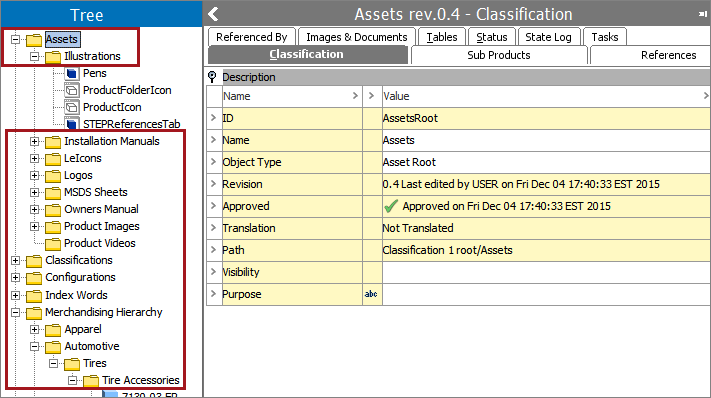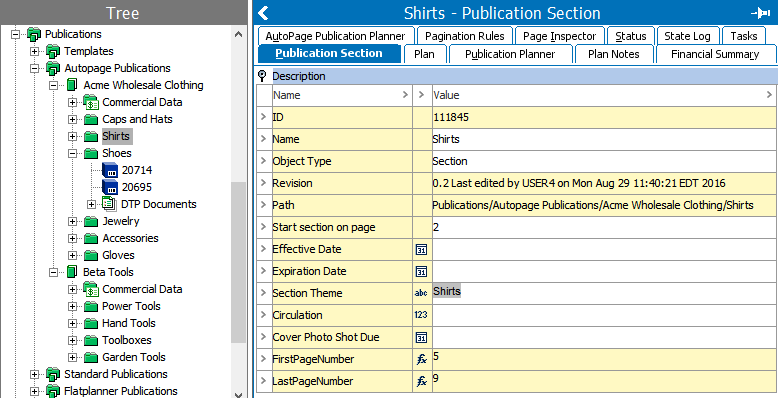This topic provides an introduction to the STEP object super types. It will be helpful to have read and understood the Basic STEP Concepts topic in this guide (here) prior to reading this material.
Object types that make up the standard STEP hierarchies accessible on the Tree tab in workbench are referred to as Tree Object Types. Many of these object types can be further grouped into five categories of object types, referred to as the super types. This topic introduces the five primary object super types in STEP. Understanding the differences between the various object super types is important when making decisions about how to model data in STEP.
Each super type has specific characteristics that make it suitable for modeling particular types of data. For example, inheritance of data is available within the Product super type so objects that share data based on common characteristics are typically modeled using this super type. Alternatively, digital media files are housed using the Asset super type, which allows for automatic reading and storing of asset properties such as size and format. Any number of individual object types within each super type can be created. For example, a system may use both an 'Icon' object type and an 'Illustration' object type (along with any number of others) within the Asset super type.
The object super types are:
Each is described below, along with links to more detailed information for working with the various super types.
Assets
The Asset super type is used to hold any type of digital media, including images, videos, documents, and text files. Assets are organized within classifications, and can be linked to other objects in STEP using references. Specifically, assets can be linked to objects of the Classification, Entity, or Product object super types. Upon import, STEP populates some basic information about each asset, which can be viewed under the System Properties flipper on each asset, but cannot be edited. Default asset icons vary by file type, and can be updated by admin users.

For more information on working with assets, refer to the Assets topic within this guide here.
Classifications
The Classification super type is used to build hierarchies and objects that bundle other objects into organized groupings. These are represented by default with yellow folders in STEP, though these icons may be updated by an admin user. For example, images, manuals, and icons could be uploaded to STEP as assets and stored in appropriate subfolders under the 'Assets' classification folder. Product objects could also be linked into classifications to provide alternative categorizations of objects that vary from the product hierarchy structure.

For more information on working with classifications, refer to the Classifications topic in this guide here.
Entities
The Entity super type is used to create hierarchies and objects that do not require inheritance of data through categorized groupings. Entities are commonly used to store customer, location, or person data, as well as to store reference data. In addition, entities are used to store source data for golden records. Entities are represented by gray folders and white and gray cubes by default, but these can be updated by an admin user, as is evident in the screenshot below.

For more information on working with entities, refer to the Entities section of this guide here.
Products
The Product super type is used to create hierarchies and objects that use inheritance of data for objects categorized by similar characteristics. In STEP, products are represented by default with blue icons either as folders or nodes, though these icons can be updated by an admin user. Upper nodes in a product hierarchy are often categories and subcategories, with leaf nodes being actual objects. Whether an organizational folder, sellable object, or something else, each node in the hierarchy is of the product super type, and all child objects are able to inherit attributes and values from parental objects.

For more information on working with products, refer to the Products section of this guide here.
Publications
The Publication super type is used to create hierarchies and objects used for print publishing solutions, including Print Publisher, Print Flatplanner, and Print AutoPage. Publication objects are used to create templates used in print solutions, as well as publications such as catalogs or pamphlets. Product objects can be linked into publication hierarchies, meaning data from the product(s) will be reflected in the publication. Publication objects use green icons by default, though these can be updated by an admin user.

For more information on working with publication objects, refer to the Publication Hierarchy section of the Publisher (Adobe InDesign Integration) documentation here.